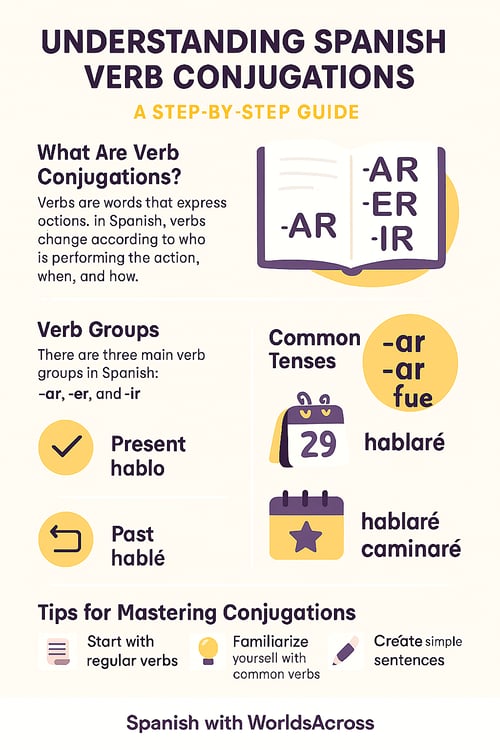Understanding Spanish Verb Conjugations: A Step-by-Step Guide
Have you ever felt lost in a sea of verbs and conjugations? Don’t worry, you’re not alone. Spanish verb conjugations might seem complex at first, but they are essential tools for expressing time, mood, and person in your sentences. These powerful tools help you understand the structure of the language and allow you to share your stories and experiences with clarity and precision. In this article, we’ll break down Spanish conjugations in a simple and fun way, including practical examples and helpful tips. So, get comfortable, and let’s dive in!
What Are Verb Conjugations?
Verbs are words that express actions, like “hablar,” “comprar,” or “agarrar.” In Spanish, verbs change based on three key factors: who is performing the action, when it’s happening, and how it’s being carried out. So, when we talk about “conjugation,” we refer to the changes verbs undergo depending on these elements.
For example, the verb comprar (to buy) changes depending on who is speaking:
- Yo compro (I buy)
- Tú compras (You buy)
- Él/Ella compra (He/She buys)
Understanding Verb Groups
To master Spanish conjugations, it’s crucial to know the three main verb groups. These groups are based on their endings: -ar, -er, and -ir.
Verbs ending in -ar: jugar, lanzar, caminar.
- Example: Iré a caminar un rato por el parque. (I’ll take a walk in the park.)
Verbs ending in -er: comer, leer, encender.
- Example: Me gusta leer antes de ir a la cama. (I like to read before bed.)
Verbs ending in -ir: abrir, decidir, salir.
- Example: Perdí mis llaves y no pude abrir la puerta. (I lost my keys and couldn’t open the door.)
Mastering Spanish Verb Tenses
Now that we’ve covered the basics, let’s dive into the most common verb tenses: past, present, and future. Don’t worry—we’ll keep it simple and include practical examples to make learning easier. Let’s go!
1. Present Tense
The present tense is probably the one you’ll use the most in your daily life. It’s used to talk about actions happening right now. Here are some examples with the verbs jugar (to play), leer (to read), and abrir (to open), conjugated for different subjects:
Jugar:
- Yo juego
- Tú juegas
- Él/Ella juega
- Nosotros jugamos
- Ustedes juegan
- Ellos/Ellas juegan
Leer:
- Yo leo
- Tú lees
- Él/Ella lee
- Nosotros leemos
- Ustedes leen
- Ellos/Ellas leen
Abrir:
- Yo abro
- Tú abres
- Él/Ella abre
- Nosotros abrimos
- Ustedes abren
- Ellos/Ellas abren
Great! Now you know how to conjugate in the present tense. Let’s explore the other tenses!
2. Past Tense
The past tense, also known as the preterite, lets us describe actions that have already happened. Here are some examples using the verbs hablar (to speak), romper (to break), and compartir (to share):
Hablar:
- Yo hablé
- Tú hablaste
- Él/Ella habló
- Nosotros hablamos
- Ustedes hablaron
- Ellos/Ellas hablaron
Romper:
- Yo rompí
- Tú rompiste
- Él/Ella rompió
- Nosotros rompimos
- Ustedes rompieron
- Ellos/Ellas rompieron
Compartir:
- Yo compartí
- Tú compartiste
- Él/Ella compartió
- Nosotros compartimos
- Ustedes compartieron
- Ellos/Ellas compartieron
Well done! If you enjoy sharing stories and experiences, mastering the past tense will be incredibly useful.
3. Future Tense
The future tense is perfect for expressing something that will happen. You can recognize it by the emphasis on the last syllable of the verb, often accompanied by an accent mark. Here are some examples with the verbs cocinar (to cook), aprender (to learn), and subir (to go up):
Cocinar:
- Yo cocinaré
- Tú cocinarás
- Él/Ella cocinará
- Nosotros cocinaremos
- Ustedes cocinarán
- Ellos/Ellas cocinarán
Aprender:
- Yo aprenderé
- Tú aprenderás
- Él/Ella aprenderá
- Nosotros aprenderemos
- Ustedes aprenderán
- Ellos/Ellas aprenderán
Subir:
- Yo subiré
- Tú subirás
- Él/Ella subirá
- Nosotros subiremos
- Ustedes subirán
- Ellos/Ellas subirán
Congratulations! You now know how to use Spanish verb tenses to share past stories, talk about what you’re doing today, and express your dreams, plans, and goals for the future.

Tips for Mastering Spanish Conjugations
- Start with regular verbs: Regular verbs follow consistent and predictable patterns, making them easier to learn.
- Familiarize yourself with common verbs: Focus on high-frequency verbs like ser, hablar, decir, comer, and hacer. Once you master these, the rest will come easier.
- Use flashcards: Writing what you learn significantly improves retention. Create small flashcards with verbs and their conjugations in different tenses.
- Create simple sentences: Practice forming small sentences related to your daily activities. For example:
- Yesterday, I visited an old friend.
- I drink coffee every day.
- Tomorrow, I will walk 5 kilometers.
- Don’t be too hard on yourself: It’s normal to make mistakes at first. Just keep studying and practicing—remember, practice makes perfect!
Mastering Spanish conjugations might seem challenging at first, but the positive impact they have on your conversations is worth the effort. Don’t be afraid to practice using flashcards, creating sentences, or even repeating out loud. Every bit of effort counts, and with each verb you conjugate, you’re one step closer to fluency.
Good luck!





